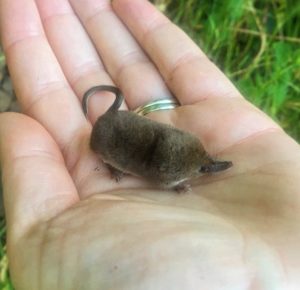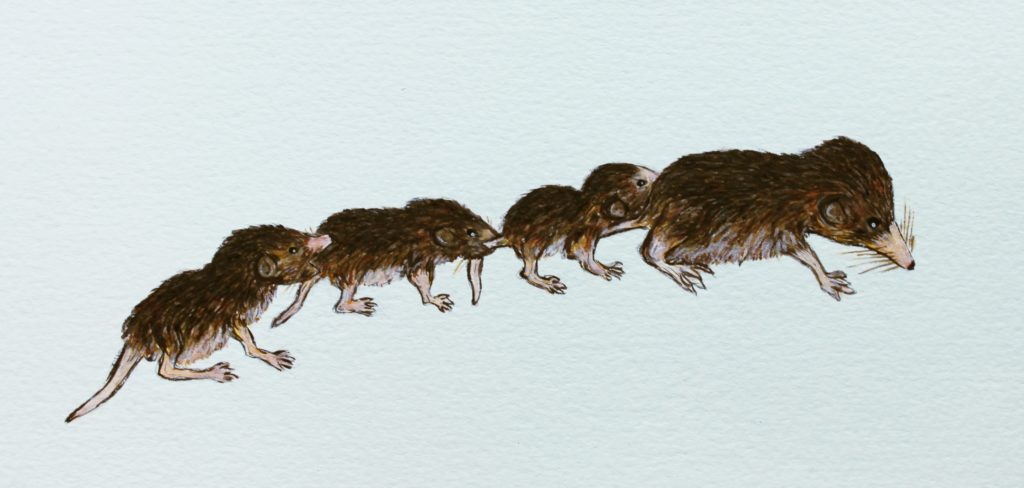
If you thought that a shrew was just, ‘a kind of a mouse with a funny nose’, then you’d be wrong. These tiny mammals actually have more in common with hedgehogs and moles than they do rodents and are pretty interesting in their own right.
But, why I am writing about shrews? Whilst eating breakfast I saw our Big Cat faffing about like a ninny on the lawn. There is nothing particularly special about this, he is a strange fellow and is often seen behaving in delightfully joyous, but daft ways. At first it looked as if he were trying to dance a jig on four legs, but from past experience I knew that he was excited – he had caught something. Now, big cat is not an adept hunter (for which I am glad) and he is such a sweet, gentle and odd soul that, when he does actually catch something, he has no idea what to do with it. He will often wander around with it held gently and unharmed in his mouth and will let me take it from him. (It is small cat who will one day take over the world and destroy everything in his wake to do so.)
And so I found myself relocating a tiny shrew into one of our tree-lined hedges.
Let us examine the shrew. They have dense, velvety fur which is white-ish underneath, pale at the sides and is darker on top. We cannot ignore the long nose, which makes it so readily identifiable, it has small ears and poor eyesight. Unlike rodents, whose front incisors continue to grow throughout life, the shrew has small, spike-like red-tipped teeth which wear down over time – and that’s after having already lost its milk teeth before birth. They are small, 5-8 cm, with a tail of around 2-4 cm but, and this is where I land the first awesome fact for you, they can shrink – on purpose.
Shrews do no hibernate, instead they enter a state of torpor over the winter months. To aid this reduction in energy cost and need, they undergo an amazing morphological change; they shrink. Their spines shorten, their internal organs, bones, brain and even skull reduce in size. When the weather improves and they are able to go about their foraging with vigour once more, they grow back to their bigger size.
They are foragers and will eat insects, spiders, worms, small slugs and snails, chrysalis as well as nuts and seeds; and they need a lot. Shrews need to eat every 2-3 hours just to stay alive and will consume between 100% and 300% of their own bodyweight to survive; partly because they are frenetic creatures, zipping about at incredibly fast speeds. (The average weight of a woman in the UK is around 70kg, the equivalent of the shrew’s intake would be like consuming 350 200g bars of chocolate – a day!)
Shrews are feisty and promiscuous. That’s right, when the mating season begins its worse than a Saturday night when the nightclubs have closed and it’s a free-for-all; a-fightin’ and a-lovin,’ and naturally, the shrew equivalent of a kebab after. They are highly territorial creatures and the females (who will have 2-5 litters of 5-7 young) will often raise a litter fathered by several different males. But here’s the awwww moment, shrews have been seen to move in a ‘caravan,’ whereby the young follow their mother in a line, each holding the tail of the one in front in their mouth.

But all this activity can be dangerous exposing them to their varied predators. They are most often killed by owls, but weasels, stoats, foxes, kestrels and cats will have a go to. However, they do not prove to be the fine dining experience wanted and are often abandoned due to secreting a foul tasting liquid from glands on their skin. Which is why, if you are a cat owner you may find shrews abandoned in various places about the house. Your cat is not showing you adoring love by giving you a gift, it just doesn’t like the taste of its take-away and wants you to get rid of it for them.
I mentioned at the start that shrews have poor hearing and eyesight but they have a possible secret talent to aid their foraging and navigation. It is thought that they perhaps use a form of echolocation; not the clicks, but ultrasonic high-pitched squeaks to create an echo scene of their surroundings. (I have also just read that hedgehogs use ultrasonic whistles – I must look into this more!) For hunting, they make use of that mobile snout and highly sensitive whiskers which they waggle around constantly and once they brush up against something recognised as prey, they attack at high speed and with pin-point precision.
To recap: red teeth, can shrink at will, eat more than their body weight a day, love a good fight and getting some lovin,’ echolocate and secrete foul liquid from the skin – pretty awesome, hey?
Most shrews do not live longer than a year, so it’s perhaps little wonder that they live life in the fast lane; feasting, fighting and f-well, you know.
Common Shrew – Sorex araneus